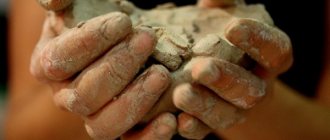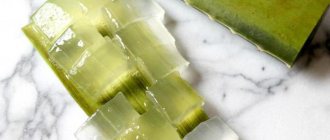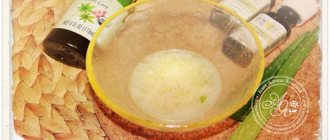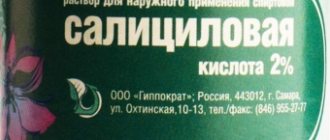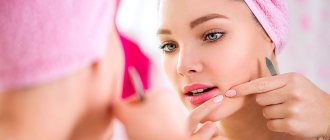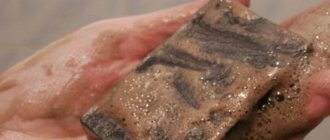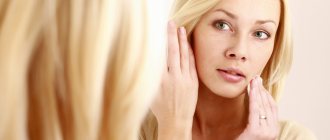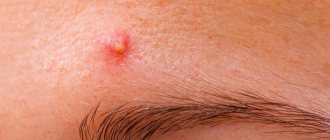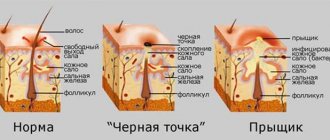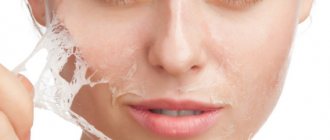The beneficial properties of aloe extract have been known for a very long time. The main advantages of the juice are its incredible effectiveness and the absence of possible side effects. The medicinal plant can be used to remove acne not only from the face, but also from the entire body, if necessary, for both men and women.
The juice has healing, cleansing, and antibacterial properties. That is why with its help you can not only remove rashes, acne and blackheads from the surface of the skin, but also prevent the formation of scars after they disappear.
When applying the medicinal juice, a protective film is formed on the skin that can prevent harmful bacteria from entering the upper layers of the epidermis and prevent the development of new acne and pimples.
Does aloe help with acne?
To understand how effective the use of agave is against acne, you should consider its composition and properties. The active components are concentrated in the leaves.
A total of 75 potentially active substances: vitamins, enzymes, salicylic acids, fatty acids and others.
- Retinol, ascorbic acid, tocopherol are powerful antioxidants. They suppress the growth of pathogenic microorganisms.
- Bradykinase (an enzyme) helps reduce excessive inflammation when applied topically to the affected dermis.
- Alonine and emodin (anthraquinones) have antibacterial and antiviral effects. Protect epidermal cells from damage by pathogenic bacteria and viral agents.
- Auxins and gibberellins (hormones) have an anti-inflammatory effect and help in wound healing.
The juice creates an invisible film on the face, retaining nutrients inside the dermal cells and preventing the penetration of bacteria. Agave not only effectively fights acne, but also prevents its occurrence.
Contraindications
Aloe contains many biologically active substances that cause allergies. The biggest allergen is aloin. Using aloe for acne is not for everyone. Therefore, before applying aloe-based cosmetics, you need to conduct an allergy test. Apply a small amount of concentrated aloe juice to the bend of your elbow and wait 12-24 hours. In the absence of redness, itching, or peeling, plant-based products can be safely applied to the skin of the face and body. General contraindications for using the plant:
- rosacea, telangiectasia - conditions in which the active ingredients of aloe extract cause microbleeding and increase the size of spider veins;
- increased facial hair, because aloe stimulates hair growth;
- pregnancy and lactation - agave can cause severe allergies, and taking antihistamines during pregnancy and lactation is not recommended;
- may cause hemorrhoidal and uterine bleeding;
- contraindicated during menstruation:
- high blood pressure;
- diseases of the liver, gall bladder;
- kidney dysfunction.
You can solve the problem of acne on your own if it is a single rash. If the skin is affected by acne by more than 30%, consultation with a dermatologist is necessary. In addition to local remedies, the doctor will prescribe aloe injections, vitamin A and, possibly, antibiotics (clindamycin gel).
Use Cases
Agave is a hypoallergenic plant and interacts well with various substances. These properties allow it to be used in different ways.
Many cosmetic products are prepared based on sabur:
- Compresses draw out dirt and bacteria from the pores. Reduce inflammation, relieve swelling. Applications are applied for at least half an hour, and for severe rashes - overnight. The procedures are carried out daily until the desired result is achieved.
- Tonics and lotions are used to prevent acne.
- Masks nourish, moisturize the epidermis, stimulate regeneration processes.
- Ointments and creams. The use of homemade emulsions helps restore the water-electrolyte balance of the epidermis and reduce irritation.
Be sure to read:
The best film masks for blackheads at home: how to make, application rules
The remedies are selected based on the severity of the rash and the desired effect.
Treat boils and wen with aloe vera
As already mentioned, the extract has the property of drawing out pus and excess fat through small pores of the skin, so it can be used in the fight against subcutaneous wen and boils.
The first ones can be wiped with alcohol tinctures. And to get rid of the latter, you can use “applications” from fresh leaves of the plant. To do this, you need to cut the sheet lengthwise and place the cut on the boil, and then attach it with a plaster. This compress must be kept overnight.
However, it is worth remembering that the only disadvantage of aloe vera may be an allergic reaction to its components, so you first need to undergo a mini-test to determine its tolerance.
Compresses and lotions
For severe rashes with purulent contents, compresses should be applied. Applications, penetrating deep into the pores, draw out purulent exudate, relieve inflammation, and soothe irritated dermis.
For compresses, the leaves are used either alone or in combination with other components.
- The pulp of the plant is lightly kneaded on a gauze napkin. Fold the gauze in half so that the paste does not fall in and apply it to the face for at least half an hour. It is recommended to apply compresses to problem areas at night, securing them with adhesive tape.
- Squeeze the juice from the young shoots and mix with olive oil in a 1:1 ratio. A napkin is moistened in the prepared solution and applied to the inflamed area.
Pustular elements are more often observed in women with oily skin. The secretion of the sebaceous glands is a breeding ground for pathogens, and its excess accelerates the proliferation of bacteria. Girls with oily dermis need to treat their face with lotion every day.
To prepare the lotion, take 2 teaspoons of calendula infusion and add 3 tsp. juice of a medicinal plant. The prepared solution is used to treat inflamed lesions 2-3 times a day.
Using homemade lotion for preventive purposes will help prevent the occurrence of acne and get rid of oily sheen.
Chemical composition
The importance of the plant from a medical point of view is due to the presence of a complex chemical composition. It contains more than 200 useful components that can neutralize the spread of skin infections, which are often the main causes of a large number of acne and other rashes.
This includes vitamins A and B, including even the rarest of them, for example, B12, vitamins C and E. A large number of micro- and macroelements, as well as amino acids, have a beneficial effect on the general condition of the skin. Lingins, which are also found in the pulp, are able to penetrate deep into the upper layers of the epidermis and act on foci of inflammation (pimples, blackheads, acne and blackheads) from the inside.
This complex composition determines the following properties of the extract:
- antibacterial (it has strong disinfectant properties, that is, it destroys bacteria that cause acne);
- anti-inflammatory (it penetrates into the very foci of inflammation and ensures normal restoration of skin pores after acne removal);
- restorative, or regenerating (it reduces all visible scars after acne healing, since the active substances in its composition stimulate the active growth and division of epidermal cells);
- protective (on the surface of the epidermis, the juice forms a protective layer that prevents the penetration of acne-causing bacteria);
- cleansing (it is able to draw pus from the pores, so it can be used to treat boils and even wen);
- tonic (the plant restores the skin, nourishes it with missing elements and vitamins and restores its natural elasticity and smoothness).
Rubbing your face with aloe juice
To maintain elasticity and normal humidity, it is recommended to wipe the dermis daily with sabur. The saponins it contains have a mild irritant effect, stimulating the secretion of all glands, which helps cleanse the dermis of dirt and toxins. Glucomannan, rich in mannose and gibberellin, interacts with growth factor receptors on fibroblasts, which significantly increases collagen synthesis.
Daily rubbing soothes, moisturizes the skin, and prevents flaking in harsh and dry weather. The oligoelements present in the leaves are recognized as powerful oxidants and cellular anti-aging agents. Rubbing will help maintain skin tone, keep it healthy and youthful. But only freshly cut shoots should be used for the procedure.
Be sure to read:
The best recipes with Aspirin for acne on the face: a quick way to get rid of acne at home
Aloe tree or Agave - reviews
- + Leave a review
Leave a review Reset
marinashubina
https://irecommend.ru/content/eto-prosto-moe-spasenie-6
This plant has been in our house for many years. I was still a very small child when my mother used this plant. When I became a teenager, the problem of acne began to arise. Even then, my mother told me, apply aloe and everything will go away. Well, I’m a stubborn teenager who believes not in my mother, but in the Internet, friends and magazines.
I never had any big problems with my skin, pimples appeared occasionally, which I squeezed, and if I hadn’t squeezed everything would have been much better. And when I was already 18 years old, subcutaneous pimples began to torment me, not a lot... but sometimes they appeared .I remembered my mother’s words about the aloe.
I think, well, it definitely won’t get any worse. I cut a small piece of a leaf lengthwise and applied it to the inflammation, securing the whole thing with a band-aid. I went to bed. What was my surprise when in the morning the subcutaneous layer had almost disappeared, a small red spot remained , which passed within 2 days. Since then, this has been my favorite medicine for this problem.
The following will be photos taken within 4 days
this is 1 day before using aloe
painful subcutaneous pimples
This is the morning of the second day (it no longer hurts at all, the inflammation has completely gone away)
And sooooooo day 4
I think the difference is very big. The redness also went away
This plant is really a very good salvation, whoever tries it will not regret it! I recommend it!
Yana Nikulina
https://flap.rf/Animals_and_plants/Aloe_tree_(agave)/Reviews/6157054
In my house, aloe (agave) does not take root at all. Even though aloe is an absolutely unpretentious and not capricious plant. For my mother and grandmother, it grew and multiplied with incredible force. And it’s convenient to have such a flower at home, because everyone knows its medicinal properties, which are not at all unfounded! In fact, aloe helps in many cases, for example, with a boil, aloe helps to resolve any “bad”...
Well, I’m unlucky, it’s not growing, it’s wasting away and that’s it (((It’s a pity((
Vasilissa
https://irecommend.ru/content/aloe-spaset-vashu-kozhu
Aloe vera is not just a beautiful fairy tale that promises perfect skin, it is truly an assistant for beauty!
The plant quickly heals small wounds on the skin, although it stings a little, but is tolerable. If you want to quickly tighten the pores on your face, aloe will help! Nothing is impossible for him!
I just rubbed the juice into my skin every day for half an hour, which, by the way, is not difficult to extract from the plant, and after a week I noticed that the skin not only smoothed out the pores, it became much softer and softer. Among other things, the juice also disinfects well, destroys microbes, and fights subcutaneous parasites. I won’t look so deeply - but when, after treatment for demodicosis, it was necessary to repeat the course with special preparations, aloe came to the rescue. Everything went away.
I recommend it to everyone!
Horse with a tie
https://irecommend.ru/content/aloe-2-v-1-eto-i-krasivoe-komnatnoe-rastenie-i-lekarstvennoe-sredstvo
Let's consider today an indoor (and part-time medicinal) plant - Aloe.
A little background about how I got aloe:
I wanted to buy aloe for myself (I just remember how they treated me with it as a child). But they simply don’t sell it in stores (or I didn’t look well in stores). And, one day, I meet my friend and she produces a small shoot of this plant. That's how I got this plant. And it has been growing for 3 years.
A little “official information” about this plant:
Aloe is a genus of flowering plants in the Xanthorrhoeaceae family, numbering about 500 species. Most members of the genus are succulents that grow in arid tropical regions and have mechanisms for conserving water. At the same time, plants are distinguished by their love of light and warmth. A characteristic feature of the representatives of the genus is thick sword-shaped leaves extending in all directions from the trunk, usually covered with a whitish coating and equipped with thorns along the edges. In nature, the leaves of the plant serve to accumulate moisture. For medicinal purposes, it is also mainly the leaves, sometimes parts of the stem.
Here's what they write about its beneficial properties:
It is believed that aloe vera is more useful for treating skin diseases, wounds and cuts, and aloe vera has stronger healing properties when used internally. Aloe is a unique plant. In terms of the number of active biological substances it contains (approximately 250), it has no equal among representatives of the flora. The medicinal properties of the plant are used in gastroenterology, dermatology, ophthalmology, and for the treatment of cardiovascular diseases. But do not forget about its contraindications.
Let's move directly to my experience:
1. It is very difficult to get it (except through friends) (I checked it on myself).
2. The plant is very unpretentious. The shoot took root within 2 or 3 weeks. I water it 1-2 times a week. I have it on the east side (very little light). At first it grew poorly, then it grew normally. It tolerates dry air calmly (unlike
Croton). Sometimes I give him a cold shower. The soil is the simplest, store-bought;
3. There are small thorns, but they are “not scary” (that is, getting pricked with them is very problematic).
4. As you understand, it is medicinal. But I don’t want to turn it into a “shabby tree,” so it grows just for beauty. And for all kinds of cosmetic procedures, I take aloe tincture from the pharmacy. But the cat chews it periodically;
Conclusion: I like it as a simple houseplant, an unpretentious plant.
Katya Mironenkova (Nikolskaya)
https://flap.rf/Animals_and_plants/Aloe_tree_(agave)/Reviews/6140945
Aloe grows very quickly here, I think this plant is healing, that’s why I grow it. I know a recipe for a runny nose: aloe juice with honey, but somehow it doesn’t help me. I add aloe juice to homemade masks and creams. I also heard that aloe helps with stomach ulcers, but before use it is better to consult a doctor! It will help one, it will harm another.
Nadezhda V
https://flap.rf/Animals_and_plants/Aloe_tree_(agave)/Reviews/6542705
I always thought that evergreen indoor plants
, which do not produce bright large flowers, or even lack them at all, do not require special care other than watering and replanting in new pots.
So, with the agave plant
, I expected to make no effort: I brought the shoot, planted it, and watered it as the top layer of soil dried out. Over the course of several years, from a small sprout,
Aloe
grew to the size of a mini-bush with strong stems and not too wide leaves. There was little benefit from it, since the medicinal juice had to be extracted from several leaves at once, and squeezed out with force.
Over time, aloe
began to wither, the leaves acquired a yellow-pink tint and became almost dehydrated. Outwardly it looked so terrible that I had to get rid of it.
Perhaps the fertilizer in the flower shop was chosen incorrectly, or Aloe requires special close attention and care, I can’t say, but the desire to have a new flower does not arise; Aloe and I have not developed a friendship.
RomanB
https://www.homecveti.ru/aloe-drevovidnoe.html#comment-3515
A huge advantage of this plant is that it is not whimsical. I will say this: my grandmother only had tree aloe and was able to survive; the rest could not withstand careless care. Plus, it’s quite cute, although don’t expect flowers.
Kira
https://forum.bestflowers.ru/t/aloeh-ili-stoletnik-aloe.23197/page-3#post-113849
But for some reason it grows as a bush and not a tree, maybe it’s pulling up the babies? And unfortunately, the apartment is small and in winter there is practically no sun in it, and it won’t fit on the windowsill, it’s too big and that’s why the leaves are pale green. In the summer I drag him out (I mean pull him out, not carry him out - it’s heavy) onto the loggia, that’s where he has freedom.
Olga Gorchakova
https://flap.rf/Animals_and_plants/Aloe_tree_(agave)/Reviews/6157119
Indeed, in childhood. Back then we didn’t trust medicine at all. And agave helped against all sorts of inflammations, of which for some reason there were always a lot of them, either on the fingers or on the toes. These places on my brother’s and my body’s bodies were the most susceptible to infections - we always put our hands somewhere in the wrong places and ran around with our feet a lot, played football, I even had a fracture of my thumb, which healed without any plaster. If the grandmother managed to find an abscess in an undeveloped stage, then she tied aloe to it overnight - everything went away without consequences in one or two nights. If you managed to hide it from your grandmother for a long time, then it was impossible to do without the intervention of a surgeon - the abscesses had to be opened, and there were a lot of tears (for me, anyway). Since then I have kept aloe this way. All three children had an aloe solution (juice and water) put into their noses from infancy, and it helped. I haven’t used it in any way, but they say it’s useful to take it in large quantities for chronic pneumonia and even for pulmonary tuberculosis.
Aloe is unpretentious in care. But if you damage the trunk, you cannot stop the rotting. It is better to immediately separate a healthy sprout and plant it. I don’t even remember if I immediately dug it into the ground or grew roots. In my opinion, straight into the soil. This one in the photo is also not the main one. The main trunk was damaged, it was necessary to cut it off and make way for the young ones who lived at its base. Within a month after the removal of the parent, they each grew ten centimeters upward.
Anastasia Gimadeeva
https://flap.rf/Animals_and_plants/Aloe_tree_(agave)/Reviews/4245733
Aloe is probably the most unpretentious plant. Put him in a pot and that's it. It doesn’t even need daily watering; it tolerates any temperature well. If you tear off the leaves from it, and everyone knows they are used for various medical purposes, then it’s not scary at all! Because it produces a lot of new shoots, so I usually give it out to everyone who wants it. Well, it’s probably pointless to talk about its benefits - where is it not used! Therefore - aloe to every home!
abisnet
https://forum.bestflowers.ru/t/aloeh-ili-stoletnik-aloe.23197/page-5#post-153914
I bought this flower small in a small pot 8 years ago. The years passed, the flower grew. The pots also changed. Recently, I had a renovation, I changed the window to modern PVC. Before this, the flower was not completely in the Sun. I had blinds. But now in the Sun. And suddenly, the flower began to wilt. Its succulent leaves have turned yellow and the edges have dried out.
I really want to bring the flower back to life, but I don’t know what to do? I know that you don’t need to water Aloe a lot. I recently changed the soil, but after that nothing happened. But after the renovation, it’s as if the flower does not accept its proximity to the new frame.
Vialeta
https://otzovik.com/review_7302544.html
Advantages:
It is very easy to propagate: by seeds, stem or apical cuttings, leaves and root shoots.
Flaws:
You need to know that this plant is useful only after three years of its existence!
The beneficial properties of this plant have been known since ancient times; it is also called doctor, agave, rannik. Agave got its name from popular belief, which says that it blooms once every hundred years. But if you take good care of it, it can bloom every year. This flower is a symbol of health and is grown in almost every home. Aloe juice and pulp contain many vitamins and essential oils. Juice is considered more valuable. It is used in folk medicine in the treatment of diseases of the respiratory tract, digestive orgone, and vision. Squeezing the juice can cure purulent wounds and burns. The juice is included in many medicinal and cosmetic preparations. The plant is undemanding and therefore creating comfortable conditions for it will not be difficult. I use it for example as a facial mask. If your facial skin lacks freshness, then make such a mask. The yolk of one egg, one teaspoon of plant juice and a little fat sour cream. Mix and apply to the face, neck and décolleté. Leave for 20-30 minutes. Rinse with warm water and rinse with cold. Very refreshes and tones the skin. This is one of the simplest masks.
Elena Lenina
https://flap.rf/Animals_and_plants/Aloe_tree_(agave)/Reviews/6068983
Aloe is a medicinal plant. I admit, I don’t quite understand those who grow it for the sake of beauty... What is beauty? In sausage-like curved leaves with thorns? What kind of beauty is this perverted??? I grew aloe until I made a mixture with honey and tried this rare nasty thing. Maybe it helps someone, I don’t argue, but I’d rather give aloe injections than eat this bitterness and wait for it to help me. My grandmother has a huge aloe, I water it, of course, wash it with a shower diffuser, but that’s all, no positive emotions, I don’t think it’s beautiful...
Lavrentiy
https://www.homecveti.ru/aloe-drevovidnoe.html#comment-3522
I don’t know why, the leaves of large aloe plants dry out at the tips. And yes, it requires virtually no maintenance. A leaf cut in half, personally used as a compress for wounds, tightens with a bang. I just don't really like the smell of it. Probably some essential oils are irritating, I don’t know how other people deal with this.
YuliyaKV
https://otzovik.com/review_6256549.html
Advantages:
Useful in folk medicine
Flaws:
No
I and all my relatives grow this houseplant. We use it very actively, especially in the summer, when abrasions and cuts cannot be avoided for both adults and children. The flower helps us with suppuration of wounds and a runny nose. Yes Yes!!! It is aloe juice that we bury in the nose of both adults and children. The flower is not whimsical, the main thing is not to forget to water it. It grows quickly and manages to expand from summer to summer. It happens that we plant them in the garden in the summer and dig them up for home in the winter. My grandmother told me the recipes for using the flower in folk medicine. I advise everyone who trusts traditional medicine, you won’t regret it. Write more reviews about who uses this plant and how.
Leva
https://www.imho24.ru/recommendation/38114/#review95822
Advantages:
Useful
Treats runny nose
Flaws:
Did not find
Review:
Since childhood, my mother did not expose me to various harmful drugs. Therefore, I always treated a runny nose with aloe drops. The preparation is very simple: grate the aloe and squeeze out the juice. You need to bury the juice in your nose 4-5 times a day. They are very effective, but you sneeze a lot afterwards. In order to heal sufficiently, apply nose drops for 1-2 weeks. It also helps get rid of acne well. You can add aloe to a face mask or simply apply it to problem areas. For me this is the most effective remedy. You can rinse your hair with aloe juice diluted with water.
I love that it's completely free. Agree that many people have aloe at home. And this is a natural remedy. I hope you will be pleased too.
Lucy
https://www.homecveti.ru/aloe-drevovidnoe.html#comment-3658
In the summer I replanted aloe. Several “trees”, overgrown, almost bald and yellowed, had to be thrown out. My daughter planted them in the garden (sorry about the flowers). I was very surprised when I saw the gorgeously green plants. Now I understand - aloe really loves fresh air (and apparently also fresh soil, plenty of space and good rain).
Mila
https://www.imho24.ru/recommendation/38114/#review60728
Advantages:
Free natural
Flaws:
No and cannot be
Review:
Even in recent times, this unpretentious plant was found in many homes. It was a free pharmacy at home. Now he is almost hatched in apartments, but in vain. As traditional medicine, it is indispensable. For example, for problem heels, when they are dry and cracking. You need to cut the leaf in half, get rid of the thorns and place the wet side on your heels overnight. Bandage it tightly so that it doesn’t pop out and the next morning you can see how your heels have changed, how soft they have become. All that remains is to easily remove the swollen skin. You can drop it into your nose during a runny nose. Can be applied to bruises and contusions. An excellent cough remedy if aloe juice is mixed with honey and taken in small portions. Good to use as a cosmetic product. You can wipe the skin.
Aloe face mask for acne
About 86% of manufactured cosmetic masks contain agave as a main component. The products have a whitening, bactericidal, anti-inflammatory effect. You can also make an anti-acne mask at home.
The recipes include only natural ingredients, and preparation does not take much time.
- Egg white is mixed with two tablespoons of plant pulp.
- Add 1 tsp. lemon, stir.
- The mixture is applied to the face with a soft brush and left until completely dry.
- Wash with warm water.
The mask will relieve inflammation, cleanse pores, and remove excess secretion from the sebaceous glands.
Gelatin based mask
This ingredient can be good at eliminating blackheads due to its ability to create a film on the skin. When, after 15 minutes, it needs to be removed, black comedones will remain on it.
Also, such a product will help restore softness and smoothness to the skin, it will narrow the pores, the woman will feel a surge of strength, a pleasant sensation of breathing in the cleansed areas of the face.
For preparation you will need:
- 3 teaspoons gelatin,
- 3 tablespoons of milk.
To make it correctly, you only need to do two steps:
- Mix gelatin and milk.
- Heat them over low heat. It is necessary to ensure that lumps are completely dissolved.
Next, all that remains is to apply the cleanser to your face.
Note! Avoid getting the gelatin mask on your hair.
Mask with gelatin and sour cream:
- 3 teaspoons of gelatin and sour cream;
- 4 tablespoons of boiled water;
- 3 tablespoons flour (oatmeal or wheat).
The cooking algorithm is as follows:
- Gelatin and water are mixed together. Let it brew for 40 minutes.
- After this, the container is placed in a water bath. You need to wait until the gelatin is completely dissolved.
- All that remains is to add the remaining products.
Note! For better cleansing, you can also add one tablet of activated carbon.
Aloe for blackheads
The evergreen shrub effectively fights comedones. The oily liquid of the leaves dissolves sebaceous plugs and deeply cleanses the excretory ducts. Reduces irritation, tightens pores, preventing the accumulation of dirt, bacteria and the appearance of new blackheads.
To treat comedones, you can use self-prepared tonics and masks:
- Add 1 tbsp to cosmetic tonic (50 ml). l freshly squeezed oily liquid of the plant. Soak a cotton pad in the solution and treat problem areas in the morning and evening.
- White clay (1 tbsp) is dissolved in 50 ml of mineral water and mixed with sabur. The mixture is applied to areas with blackheads for 20 minutes.
Clay absorbs dirt and excess fatty substances secreted by the sebaceous glands. Use in combination with agave will help avoid drying out the epidermis.
Aloe helps even with boils
In addition to small pimples, blackheads and blackheads, aloe can also help with boils, as the plant draws pus out.
As an aid, you can wipe the boil with aloe tincture (recipe above) or make applications: apply the cut aloe leaf with the pulp to the boil and secure with a band-aid.
The application should be left overnight. Since aloe has a powerful pulling effect, the first results are usually visible already in the morning.
How to use aloe against acne?
A good effect can be achieved only if you follow the rules for using a medicinal flower.
- It is better to select a plant older than 3 years; the older, the greater the concentration of useful elements.
- Before use, cut shoots are washed under running water.
- Leaves are stored in the refrigerator in parchment paper for no more than 2 weeks.
- I test ready-made mixtures for allergies.
It is recommended to use freshly prepared formulations.
Preparing Ingredients
In all of the following masks, aloe is a key ingredient. Some use finely chopped aloe leaves, while others require juice. It is believed that only fresh leaves of the plant should be used for medicinal purposes, but for cosmetic purposes, leaves kept in a cool, dark place should be used. To do this, cut off the lower leaves from a plant that is at least three years old, then wash them in water and wrap them in paper with a tube. Place the wrapped leaves in a cardboard box and refrigerate for 2 weeks. Under such conditions, biologically active substances are produced that make the juice as beneficial as possible for the skin. More information about the process of obtaining juice is written in the article about the unique benefits of aloe for the face.
Universal remedy with aloe for acne
Homemade recipes may contain ingredients that cause allergies (honey, herbs). This becomes the reason for refusing to use alternative cosmetics.
But among the numerous recipes there are also universal ones, containing hypoallergenic components and suitable for any skin type.
- In highly carbonated mineral water (50 ml) dilute 2 tbsp. l. Sabura.
- Add 3 drops of hydrogen peroxide to the solution.
- The composition is applied to the skin twice a day.
It is better to take medicinal-table mineral water, for example, “Essentuki 17”.
Is it relevant to use aloe for post-acne?
The high biological activity of the plant and the aloin contained in it make it necessary to handle this natural miracle healer with great care. To get rid of acne with the help of aloe and not suffer from such folk treatment, you need to familiarize yourself with the list of contraindications for its use.
If the substances in its composition interfere with the functioning of cells, systems and organs whose functioning is impaired, this will lead to a deterioration in their condition. It is not recommended to apply aloe products to an inflamed face if the following points exist:
- period of the menstrual cycle;
- lactation;
- individual intolerance to aloe;
- hypertrichosis (excessive facial hair);
- pregnancy;
- telangiectasia, rosacea (spider veins).
Understand that aloe helps against acne only if there are no contraindications for its external use as a therapeutic and cosmetic anti-inflammatory agent. Otherwise, over time (or immediately), the skin may react to such therapy with itching, swelling and irritation. So be extremely careful.
If nothing can stop you from enjoying the effects of this amazing plant, make a choice: will you buy a ready-made acne remedy with aloe extract or will you make your own homemade mask? For the first option, we have a small cosmetics rating for you.
Interesting fact: There are more than 200 species of aloe in nature.
Medical research has shown that agave juice is effective in healing serious burns by stimulating collagen production. It is this substance that is necessary to smooth out the dermis covered with scars.
To get rid of stains, you need to lubricate the problem areas with the pulp or squeezed fresh juice of the plant until the post-acne is completely eliminated. The procedure should be performed twice a day. Compresses with agave liquid are also suitable, which should be kept for about 10 minutes.
Aloe juice is absolutely harmless only if it is used externally. Even cases of allergies were not recorded.
If you use it internally, you need to be as careful as possible; it is better to consult a doctor who will give you a whole list of contraindications.
So aloe juice should not be used by those who:
- prone to allergic reactions;
- suffers from diseases that cause bleeding;
- has kidney or liver disease;
- has neoplasms on the epidermis;
- suffers from hypertrichosis (facial hair);
- has the pathology of telangiectasia (close location of blood capillaries to the surface of the skin).

